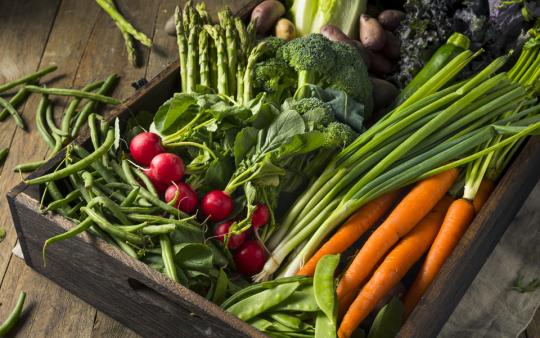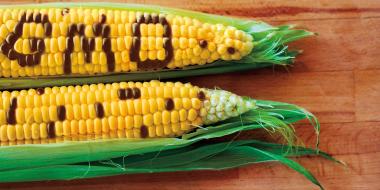You’ve probably already heard about CSAs and may have even partaken in one through a local farm or organization. But CSAs are worthy of a deeper look. They’re not just dishing up tomatoes and cukes anymore—CSAs are all about fresh, local, sustainable, and community, and here’s why you definitely want a piece of that!
CSAs: ICYMI
Community Supported Agriculture (CSA) is a farmer-to-consumer agreement that allows growers and customers to have a direct marketing relationship that’s beneficial to both parties. And while many of the modern programs incorporate some problematic features such as excessive packaging and fuel-consumption for long hauls of transportation, CSAs keep it simple while still providing fresh and local produce that you didn’t have to pick suspiciously through at the grocery store.
Three reasons to support CSAs
An emphasis on fresh, local produce and community
Many CSAs grow only using organic methods—or go further by following biodynamic practices. Vitamins start to break down in produce as soon as it is picked so the fresher the better! With the food for your box being picked the same day or the day before it gets to you, you know that it will be as nutritious as it can be without having a garden of your own. Grocery store fruits and vegetables shipped from thousands of miles away are often picked before they are ripe as well so that they last longer on the shelves. CSA food is picked at its peak ripeness—when it is chock full of vitamins and minerals.
Often a CSA is a relationship with one farm, but more and more this model is diversifying to include farmers pooling together—or sourcing goods from neighbouring farms who grow something that they don’t.
Subscriptions support the upcoming growing season
The idea for CSAs partially grew out of the need for small growers to have upfront cash to purchase seeds and equipment for the approaching season because they could not qualify for bank loans, so consumers essentially invest in the farm. The customer typically pays upon subscription in late winter or early spring for a “share” of vegetables and thus provides the needed capital for the farmer to conduct their business. Some CSAs allow for installment payments, while others charge you weekly based on the selection of produce you have made. Reduced rates in exchange for farm labour (aka singing for your supper!) are not as prevalent as they used to be but still exist.
Shares are typically sold as a full share for a family of 4 to 5 people, or a half share for 1 to 3 people. Recipes and/or food facts are often included with your pick-up to help you make the best use of the produce and try out new foods you may not be familiar with. Taking “shares” to another level, there are often farm days where members can visit the farm and eat food together or help with some aspect of the operation.
Weekly provisions to members & subscribers
In return for their investment in the farm the customer receives a share of whatever is produced. If you’re comfortable with the surprise element, some farms will give you what they got. This might mean a bounty of squash or a bean bonanza depending on how the growing season and weather worked out. Online ordering has allowed some CSAs to offer much more customization than they used to. You can avoid vegetables you don’t like, or have had enough of for the year, or order more of something your kids love or you want to use in a particular recipe. In this version of a CSA you generally have a minimum purchase for your basket each week but can opt for more and make up the difference in cost to the farmer.

How to find your new CSA
The US Department of Agriculture has a directory of CSAs in the US that you can search by entering your ZIP Code into their Local Food Directories-CSAs page. In Canada, the Canadian Organic Growers have an online directory by province or region. If you are having trouble finding a CSA near you, start by asking around at the farmers markets. Sometimes extra produce may be sold there, or the farmers market may serve as the pick-up spot for members.
Choosing a CSA is the next best thing to growing your own and it’s convenient because someone else did the hard work—all you had to do was place an order! It’s cost-effective and environmentally sustainable, plus it encourages healthy eating in the same way as buying a gym membership encourages fitness: you committed, and you don’t have to trust yourself to practice self-motivation…you paid for it, it’s right there, now eat it!
Cherry pick from one of these plum options!
Jean’s Farm is an amazing farm and learning centre that also offers a CSA for those in SE Portland or North Milwaukie, Oregon. The CSA helps support the charitable work of their non-profit educational farm—The Institute of Permaculture Education for Children. Members of the CSA are asked to volunteer 2-3 times over the growing season.
O’k CSA farms on seven active urban sites in the city of Traverse, Michigan. Education is a large part of their mandate. Included in their shares are unique offerings such as artwork and floral bouquets along with the usual vegetables.
Earth Haven Farm is a CSA in southeastern Ontario that offers many add-ons to the typical produce. This includes eggs, beef, soap, flours, herbal teas, and more. They are biodynamic farmers who are also participating members in the Indian Agriculture Program of Ontario, Farm Mentorship Program. They provide the option of a bi-weekly box if weekly is too much, as well as small, medium, and large shares to suit your family size and eating habits.
CSFs: Community Supported Fisheries
Local Catch is a network of CSFs and small-scale harvesters who connect sustainable, local fisheries with the community. Local Catch also has a comprehensive clickable map so you can find a CSF near you, like the two listed below!
Skipper Otto’s Community Supported Fishery follows the buy-down model where you pay a certain amount for your share up front and then place your order online with share credits when you would like seafood. They have a range of products available from fresh and smoked fish, to scallops, oysters, crabs and more. Their stock comes from the west coast of Canada. Main pick up locations are in Vancouver but they have quarterly pick-ups at several locations across the country.
The Heritage Shellfish Cooperative specializes in harvesting Eventide Littleneck™ clams in New Jersey. Their CSF includes various local caught fish and shellfish, all from responsibly harvested and farmed species, including lesser-known and underutilized species. Pick-up locations are in the New Jersey area.








